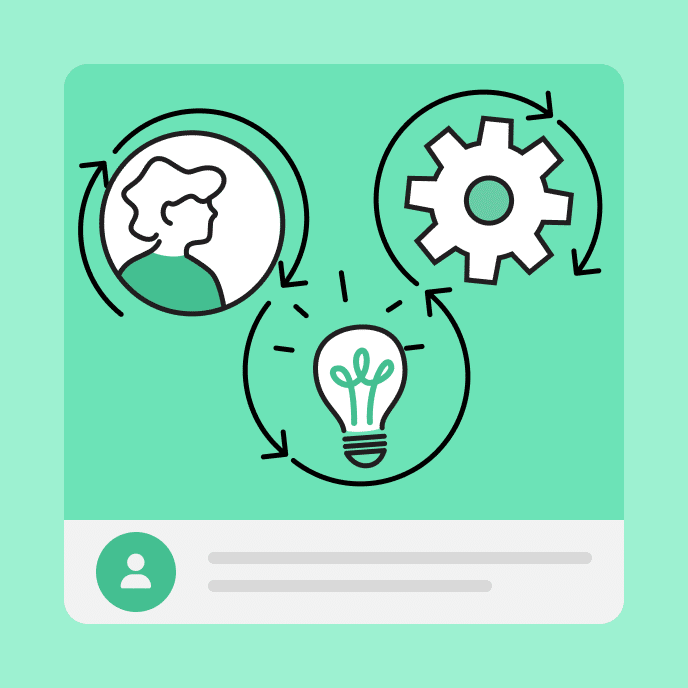Why You Need an AI Policy, Now
It’s critical to create a corporate AI policy whether your company plans to use AI tools or not. A clear policy minimizes risks and helps employees understand what AI use is OK and what is not.

Why do companies need an AI policy?
AI use in the workplace continues to surge. According to a recent survey from McKinsey, 88 percent of respondents use generative AI regularly for at least one business function. This accelerated exposure—up from 22 percent just two years ago—opens companies up to unassumed risk. A proper AI policy reduces the risk of costly security and data breaches, compliance and legal risk, and the use of biased or unfair information.
There are many parts to establishing AI guidelines. In this post, we’ll cover the basics to get you a head start on creating an effective AI policy. If you’re ready for a detailed look at establishing guidelines for an AI policy, get our free e-book, “The Beginner’s Guide to Drafting an AI Policy,” for more tips.
Key Takeaways
How does an AI policy protect against risk?
A clear AI usage policy ensures everyone understands the rules and the specific context in which they can use artificial intelligence. A corporate AI policy eases the decision-making burden, so there are no “act now, ask for forgiveness later” scenarios. Even if your company doesn’t currently use AI platforms, it’s critical to educate employees and have a policy that outlines the safe, private, and secure use of AI.
This is true when you don’t have organizational plans to use AI, but even more true when you plan to implement AI technology at work. A set of guidelines ensures that the organization moves in a unified direction without big missteps. Burying heads in the sand presents too many risks.
Why monitoring AI use matters
Whether you know it or not, employees are already using AI technologies or may try AI soon. Recent Gallup research reveals the risk. It found that 44 percent of leaders have no idea if their teams leverage AI. Furthermore, a Microsoft report found that 52 percent of employees don’t want their bosses to know they’re using DIY AI, or AI sourced by the employee, without appropriate enterprise-level protections.
In other words, what you don’t know can hurt you. Whether your company plans to use AI or not, you need an organizational AI policy. The purpose of an AI policy is to ensure compliance with consistent and approved behavior in AI tools by all employees.
What the growth of AI tools mean for your organization
The accelerated exposure of AI use in the workplace is significant. Since ChatGPT’s launch in 2022, AI generated content has become a core business and media focus. What does that mean for organizations that want to understand the AI landscape and manage the use of AI at work? Even if you’re not sure how your employees will use AI in the future, an AI policy will protect your employees, customers, and the business from potential risks. Establish a policy now, and set your organization up for long-term success.

How to create an AI policy
To create an AI policy, organizations typically begin by clarifying the purpose and scope of the policy, outlining specific guidelines surrounding AI use, addressing governance, building an oversight process, and providing employee training.
Let’s take a closer look at the six steps to get started with your corporate AI policy.
1. Clarify purpose and goals
First, gather stakeholders to establish the purpose and goals of the policy. You want safe and effective systems—how will you achieve that goal? As stated above, the primary goal of an AI policy is to ensure consistent and approved behavior among all partners impacted by the policy. Think through, generally, why you need a policy. For example, the policy would help all those affected understand approved tools and permitted use cases. Consider language regarding expectations for ethical and responsible practices.
2. Explain scope and communication
Next, consider the AI policy’s scope:
- Who does the policy cover? Consider employees, vendors, contractors, temporary workers, and consultants.
- How will a remote, hybrid, or in-office working model impact the AI policy?
- Should you consider local regulatory impact? What about international laws? For example, where customers or employees live and work could impact the policy.
- What kind of AI tools might the company need, and what are the use cases and impacted teams for those AI tools?
Finally, given the above factors, how will you communicate and update the policy? These questions are integral to laying out comprehensive guidelines.
3. Create specific AI use guidelines
Guidelines are particular to an organization. You may want to address data privacy, fairness and bias mitigation, transparency, and quality assurance practices. If applicable, detail the specialized use of AI by department.
4. Address management and governance
You’ll need to determine who manages the policy, processes and communicates changes, and enforces misuse. Clearly outline these details in the final policy. You might also identify a cross-functional team, such as HR, IT, or legal, to ensure your AI use aligns with company values and regulations. From there, define the escalation procedures for violations and decide how incidents will be tracked and resolved.
5. Build a review and feedback process
AI is constantly evolving, so your policy should be flexible enough to evolve with it. Start by creating a regular review cycle that assesses whether the policy remains relevant. Your feedback loop should include opportunities for employees to share questions or concerns, as well as any insights they’ve gained by using AI regularly in their process.
6. Provide training and ongoing education
A great policy won’t do any good unless employees are both aware of it and understand it fully. This is an opportunity to deliver training that doesn’t just inform them about policy but thoroughly explains why it matters. This training might include real-world scenarios, best practices for specific use cases, and updates on regulations and evolving technologies. Remember that the goal is to empower your team to use AI thoughtfully and responsibly.
What are the major risks of not having a corporate AI policy?
The major risks associated with not having a corporate AI policy include the usage of incorrect, biased, or unfair data, costly security breaches, data leaks, and compliance or legal risks. A proper AI policy covers each of these risks.
Here are the three major risks of not having a corporate AI policy:
1. AI can be biased or incorrect
The word “intelligence” is a misnomer. AI is only data and algorithms, not intelligence. It doesn’t know right from wrong.
Generative AI like ChatGPT or Bard is trained on broad, publicly available sources like the internet. It then generates the most probable response to user questions or “prompts.” It is not a fact-finder; it’s making its best guess. That means AI can and does offer false, partially incorrect, or correct information. It’s up to users to verify the output. Additionally, it can regurgitate offensive stereotypes. Safe, ethical AI means checking content for inaccuracy, bias, and harm.
Even a privately owned enterprise AI can make mistakes. A bad batch of data or a programming error can produce huge problems. An AI policy will include checks and balances to catch issues and minimize damage.
2. Security or data breach
Employees may not understand the data risks involved in using AI. For example, feeding private customer information into publicly available tools means that data becomes public. Clear rules help protect data privacy and make sure sensitive or private information doesn’t become AI output. Safeguard against leaks and risks with a clear policy about what tools are available and acceptable uses of those tools at work. This clarity could save the company embarrassment, protect data integrity and privacy, and reduce exposure to legal action.
3. Compliance and legal risk
AI has developed so fast that it resembles Ray Bradbury’s famous quote: ”…jump off a cliff and build your wings on the way down.” Regulation and legal implications questions continue to lag behind development and adoption.
For example, intellectual property (IP) gets murky when AI is involved, creating copyright infringement or IP ownership risk. A faulty data set may lead to poor outcomes that leave the organization open to legal issues. Complying with applicable laws and regulations about data and privacy as they emerge, like those recently passed in the EU, is much easier with a clear AI policy.
These are only a few of the key risks at stake that a corporate AI policy can begin to mitigate.
Build and establish an AI policy now for success in the future
Even if you’re not sure employees use AI now or will use it in the future, an AI policy sets the organization up for success. A policy makes goals, expectations, and behaviors clear for the company and all parties related to it. Forgoing a policy magnifies potential risks of inaccuracy, security breaches, and legal action.
To learn more about the questions you should ask when writing an AI policy, check out our e-book, “The Beginner’s Guide to Drafting an AI Policy.”
You may also like

A Guide to Customer Education: What is it? Why is it Important?
Discover the basics of customer education, why it’s essential for long-term growth, and how to create an effective program with the right tools and strategy.

